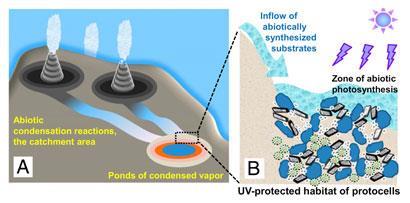Cells' ionic composition suggests life may have originated in thermal springs rather than deep sea vents
The first ’protocells’ may have arisen in puddles of liquid spewed onto the ancient Earth’s surface by thermal springs rather than near deep sea hydrothermal vents. That’s the finding of a combined genomic and geological study performed by Armen Mulkidjanian from the University of Osnabr?ck, Germany, and colleagues.
Mulkidjanian says modern cells are biological records of their primordial predecessors. Simple protocell membranes mean cell interior composition reflects where they developed, he explains. ’The first cells couldn’t have sophisticated ion-tight membranes,’ Mulkidjanian tells Chemistry World. ’They could occlude proteins and polynucleotides but should have been leaky for small ions and molecules. If so, then the cells’ ion content should be similar to the surroundings.’

If that’s true and primordial cells originated in the ocean, internal ionic concentrations in modern cells should be higher in sodium and lower in potassium, zinc and phosphate. To show cells’ ionic contents didn’t begin like that and change later, Mulkidjanian’s team investigated protocells’ internal conditions. They identified proteins shared by all cellular organisms, which likely originated from a last common ancestor. To do this, Michael Galperin and Eugene Koonin from the US National Center for Biotechnology Information in Bethesda, Maryland, analysed genomes from ’all branches of the tree of life’.
They identified many common proteins from ribosomal protein synthesis machinery, which need potassium to function, but are inhibited by sodium. Mulkidjanian and his PhD student Daria Dibrova also showed potassium, zinc and phosphate ions were important in these common proteins’ ancestors. Mulkidjanian asked geologist Andrew Bychkov, at Moscow State University, Russia, which conditions might provide this ionic balance. Bychkov identified geothermal fields like those in the Russian peninsula of Kamchatka and the Yellowstone National Park in the US.
But Nick Lane, a biochemist at University College London, UK, isn’t drifting away from the hydrothermal vents theory of the origin life just yet. He disagrees that protocell contents would reflect their environment. ’Cells require dynamic disequilibrium - that is what being alive is all about,’ he says. ’And there’s very good evidence that the last common ancestor of all life could already use gradients of protons or sodium ions across membranes.’
However, Mulkidjanian is adamant that disequilibrium wouldn’t be possible for small molecules and ions in these cells. ’If you turn it around, the disequilibrium we have now is down to the need to keep conditions similar to those in which the cells emerged,’ he says. ’It’s not an intrinsic part of life.’
Andy Extance
References
et alProc. Natl. Acad. SciDOI: 10.1073/pnas.1117774109






No comments yet